
Komodo National Park History, Location, Flora, Fauna
The Komodo National Park It is located in the center of the Indonesian archipelago, between the islands of Sumbawa and Flores. It was established in 1980 with the purpose of conserving the Komodo dragon (Varanus komodoensis) and its habitat..
However, over the years, the objective of the park has expanded to protect all the species that inhabit the area and are endemic to it. This includes both marine and terrestrial biodiversity. In 1986, the park was declared a world heritage site and a biosphere reserve by UNESCO, thanks to its biological importance.
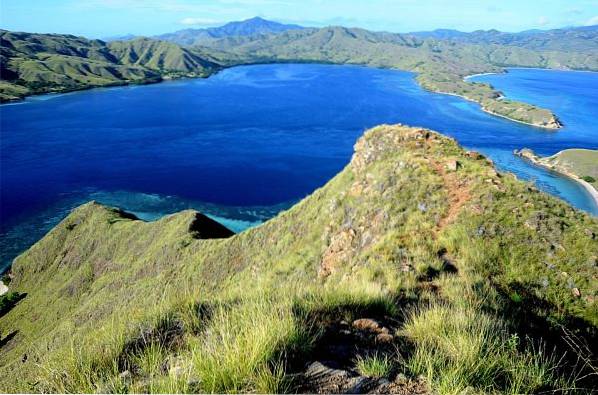
The park has one of the richest marine territories in the world, including coastal reefs, mangroves, seagrass beds, seamounts and semi-enclosed bays. These habitats are home to numerous species of coral, sponges, fish, mollusks, marine and aquatic reptiles..
Today, it is estimated that approximately 4,000 people live inside the park, and at least 17,000 inhabitants live around it. These individuals are located in four settlements (Komodo, Rinca, Papagarán, Kerora), and are mainly engaged in fishing. They have a low educational level (up to four grades of primary school).
The Komodo National Park has numerous species of fauna and flora, all of these threatened by the increase in the human population within the reserve..
This population has increased by 800% during the last 60 years, consuming a large part of the resources present within the Park.
Article index
- 1 Location of Komodo National Park
- 2 Komodo Islands
- 3 Topography
- 4 Geology
- 5 Climate
- 6 History
- 7 Demographics
- 8 Education
- 9 Health
- 10 Sociocultural and anthropological conditions
- 10.1 Traditional customs
- 10.2 Religion
- 10.3 Anthropology and Language
- 11 Fauna
- 11.1 Terrestrial fauna
- 11.2 Marine fauna
- 12 Flora
- 13 References
Komodo National Park location
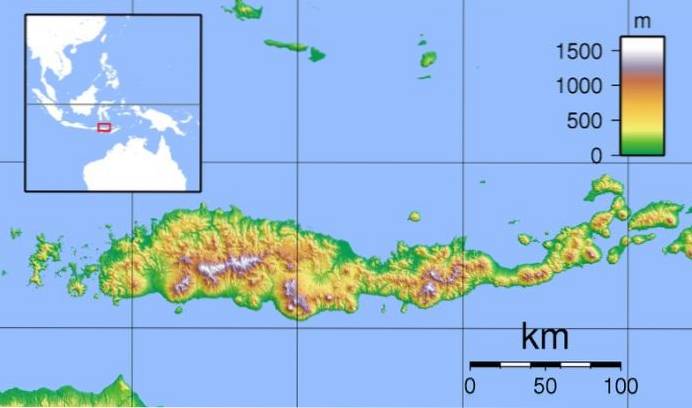
The Komodo National Park is located in the center of the Indonesian archipelago in the Wallacea region of said region.
It is located between the islands of Sumbawa and Flores, on the border with the provinces of Nusa Tenggara Timur (NTT) and Nusa Tenggara Barat (NTP).
The total area of the park is 1,817 km2. However, the possibility of extending the park 25 km2 over the territory of Banta Island and 479 km2 over marine territory is being studied, with the aim of having a total area of 2,321 km2 (Park, 2017).
Komodo Islands
Komodo National Park includes three main islands: Komodo, Rinca, and Padar, along with numerous smaller islands..
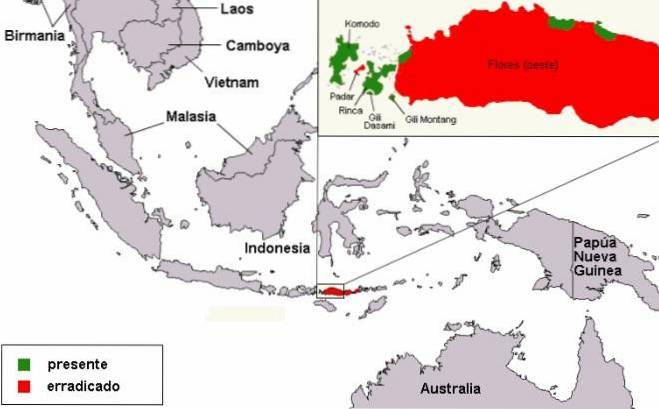
All of them are home to the Komodo dragon. The park is designed to be a refuge for the dragon and other species of birds, rodents and mammals such as the Timor deer.
The park has one of the richest marine territories in the world, including coastal reefs, mangroves, seagrass beds, seamounts and semi-enclosed bays..
These territories are home to more than 1,000 species of fish, approximately 260 species of coral structures and 70 species of sponges..
On the other hand, Komodo National Park is home to Dugongs, sharks, manta rays, at least 14 species of whales, dolphins and sea turtles (Komodo., 2013).
Topography
The park's topography is varied, with slopes ranging from 0 ° to 80 °. There is not much flat land (only on the beach). The altitude varies from 0 to 735 meters above sea level. The highest peak is the Gunung Satalibo on Komodo Island.
geology
The islands of the Komodo National Park are of volcanic origin. Two continental plates converge in the area: Sunda and Sahul.
The friction between these two plates has led to numerous volcanic eruptions, causing the appearance of numerous coral reefs..
Although there are no active volcanoes in the park, tremors from Gili Banta and Gunung Sangeang are common..
Weather
The Komodo National Park has little rainfall, spending approximately 8 months of the year in the dry season and later being impacted by monsonal rains..
High levels of humidity are only found in the semi-cloudy forest region, on the tops of the mountains and their ridges. Temperatures range from 17 ° C to 34 ° C with a relative humidity of 36%.
From November to March, the winds come from the west, generating the appearance of large waves that hit Komodo Island. From April to October, the wind is dry and strong waves hit the southern beaches of Rinca and Komodo Island..
Story
The Komodo National Park was established in 1980 and was declared a World Natural Heritage and Biosphere Reserve by UNESCO in 1986.
The park was initially established to conserve the Komodo dragon (Varanus komodoensis), a unique reptile species first discovered by scientist J.K.H. Van Steyn in 1911.
Since then, the objectives of conservation and protection of the marine and terrestrial biodiversity of the area have expanded, encompassing any form of life (Conservation, 2000).
Most of the people in and around the park are fishermen from Bima (Sumbawa), Manggarai, southern Flores, and southern Sulawesi. Those who come from South Sulawesi belong to the Suku Bajau or Bugis ethnic groups.
The Suku Bajau were originally nomads, moving from place to place within the region of Sulawesi, Nusa Tenggara, Maluku and its surroundings..
The descendants of these tribes are the original inhabitants of Komodo, known as the Ata Modo, for this reason they still live on the islands, preserving their culture, language and cultural heritage..
Today, little is known of the history of the Komodo people. These were subjects of the Sultan of Bima, although the islands are located remotely from the territory of Bima, it is likely that their sultan demanded tribute from the inhabitants of the Komodo islands.
Demography
It is estimated that approximately 4,000 people live inside the park, located in four settlements (Komodo, Rinca, Papagarán, Kerora).
These settlements are villages that existed before the park was declared a nature reserve in 1980. In 1928 only 30 people lived in the village of Komodo and approximately 250 on the island of Rinca..
The population within these territories increased rapidly and by 1999, 281 families lived there, with 1,169 people inhabiting Komodo, which means that the population of the area grew exponentially..
The village of Komodo is known to have had the most significant increase in its number of inhabitants within the park. This was mainly due to the migration of people originating from Sape, Madura, South Sulawesi and Manggarai.
The number of existing buildings in Kampung has also increased significantly, from 39 houses in 1958, to 194 in 1994 and 270 in 2000..
The Papagaran village is similar in size to the Komodo, with a total of 258 families and 1,078 inhabitants. In 1999, the population of Rinca was 835 inhabitants and that of Kerora had 185 people.
Currently, it is estimated that approximately 4,000 people live inside the park and around it there is a population of almost 17,000 individuals (UNESCO, 2017).
Education
The average educational level of the population living in the interior of the Komodo National Park reaches the fourth grade of primary school. There is a primary school in each of the villages of the reserve, but not every year new students are recruited.
On average, each village has four classes and four teachers. Most of the children of the small Komodo islands (Komodo, Rinca, Papagarán, Kerora and Mesa) do not finish primary school.
Less than 10% of those who graduate from primary school go on to secondary school, since the greatest economic opportunity in the area is offered by fishing activity and this does not require formal education.
Health
Most of the villages located around the park have some sources of drinking water available, which are scarce during the dry season. The quality of the water is affected during this season and for this reason many people get sick.
Malaria and diarrhea diseases greatly affect the people who inhabit the islands. On Table Island, there is no potable water serving its 1,500 inhabitants. Drinking water is brought by boat in plastic containers from Labuan Bajo.
Almost all the villages have a medical services headquarters with paramedical personnel. However, the quality of medical services is low.
Sociocultural and anthropological conditions
Traditional customs
The traditional communities of Komodo, Flores and Sumbawa have been influenced by external cultures, for which their traditions have disappeared to a greater extent..
The presence of television, radio, and mobile media have played an important role in the loss of cultural tradition..
Religion
The majority of fishermen living on the Komodo Islands and its surrounding sectors are Muslim. Hajis have a strong influence on community development dynamics.
Fishermen in South Sulawesi (Bajau, Bugis) and Bima are mostly Muslim. However, the Manggarai communities are primarily Christian..
Anthropology and Language
There are different cultures that inhabit the park, particularly on Komodo Island. These cultures are not well documented, for this reason there are many doubts regarding the inhabitants of the islands. The language spoken in most communities is Bahasa Indonesian.
Fauna
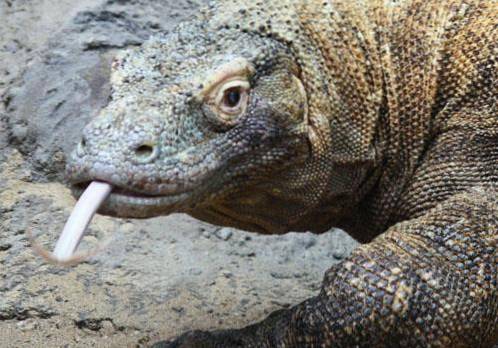
The Komodo National Park has numerous species of fauna and flora. These species are in danger of extinction due to the increase in the human population within the reserve, which consumes the aquatic resources and wood in the area. This population has increased by 800% during the last 60 years.
Additionally, the Timor deer population (the Komodo dragons' preferred prey) has been severely affected by poaching..
Destructive fishing practices such as the use of dynamite, cyanide and compressor fishing have dramatically affected the park's marine resources by destroying both habitats (coral reefs) and resources (fish and invertebrate fauna)..
The current situation of the park is characterized by a slow but continuous destruction of the ecosystem.
The fishing practices carried out by foreign fishermen mainly, and the high demand for the consumption of lobster, oysters, groupers, and other marine species have led to the dumping of chemicals in the area and threaten the future of the reserve..
Currently, various parks in the Komodo region are helping the reserve so that its resources are preserved, with the objective of protecting the biodiversity (terrestrial and marine) of the area (Komodo, 2015).
Terrestrial fauna
The terrestrial fauna of the park is relatively poor in diversity compared to the marine fauna. The number of terrestrial animal species found in the Park is low, but the area is important for its conservation, since most of these species are endemic to the area..
Most mammals are of Asian origin (reindeer, pigs, macaques and gumbos). Some reptiles and birds are of Australian origin, including the orange-tailed Norway lobster, the galerita cockatoo, and the screaming filemon..
Dragon by Komodo
The most representative animal in this park is the Komodo dragon. They are large lizards, since they can measure up to 3 meters long. Their weight can reach 9 kilos and they are characterized by being great predators..
A peculiarity of these reptiles is that their saliva has poisonous compounds that kill their prey once it has been in contact with it. They tend to shelter from the hot weather in burrows that are dug by themselves.
Java Spitting Cobra
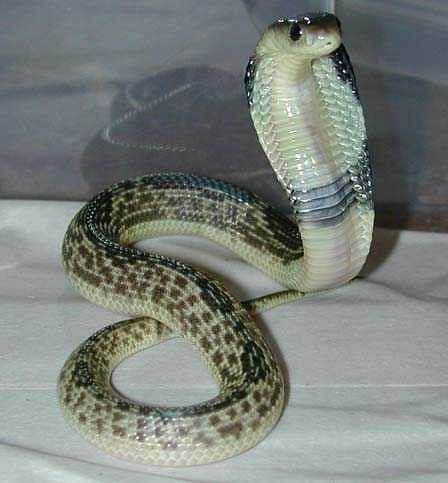
This cobra is endemic to Indonesia and is considered quite dangerous because it is very poisonous. It is capable of measuring up to 1.80 meters and although it is more common to find it in tropical forest environments, it also adapts to drier habitats.
It feeds mainly on mammals, although it can also eat frogs or lizards. The Javanese spitting cobra is one of the Komodo dragon's favorite prey.
Russell's viper
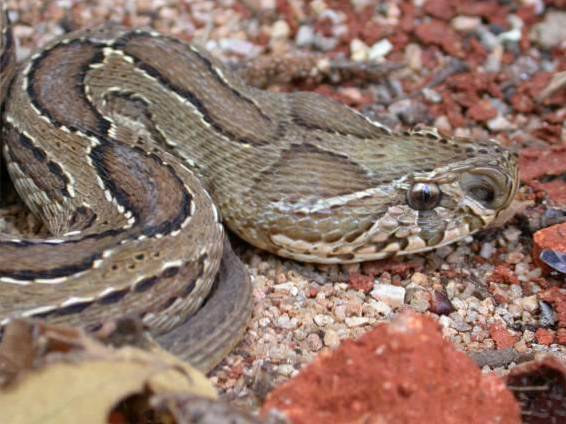
It is also known as the chain snake. It can be found throughout Asia and it is very common for it to inhabit places populated by humans. For this reason it is considered one of the main causes of bites in humans.
The venom of this viper can be lethal when it has been exposed to between 40 and 70 mg of it.
Timor deer
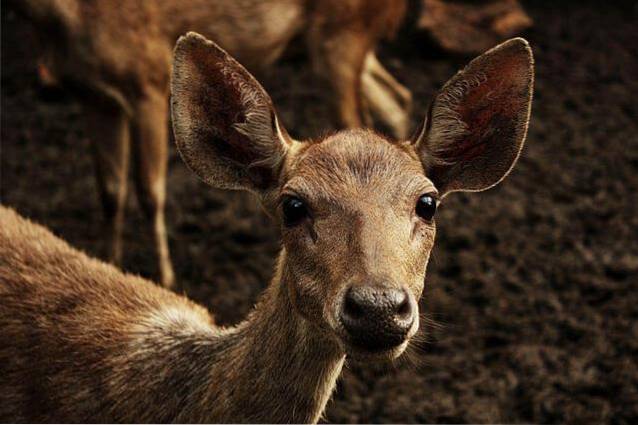
This mammal is native to the islands of Timor, Bali and Java, for this reason it is also known as the Javanese sambar.
Timor deer are commonly found in open habitats, such as savannas. It is also common to find them in denser forests.
It is a not very large mammal and is one of the main foods of the Komodo dragons.
Komodo rat
This animal is also endemic to Indonesia. It is considered a species in a vulnerable state, although it is possible that it remains out of danger thanks to its excellent ability to adapt to new habitats.
It is common to find this rodent in the gardens of human populations and they also tend to take refuge in rocks near rivers.
Marine crocodile (Crocodylus porosus)
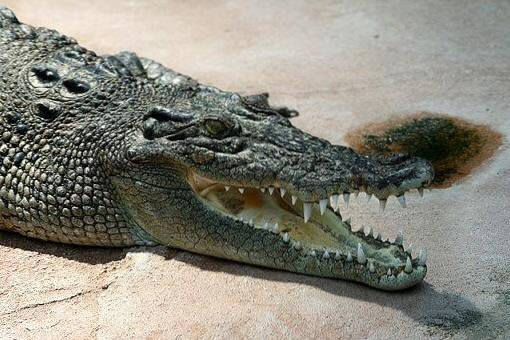
This is the largest crocodile that exists: a male specimen can weigh up to 1500 kilos, while females weigh up to 500 kilos.
These reptiles are fast both in water and on land and are characterized by entering the sea more than other crocodiles.
The marine crocodile is capable of ingesting animals as large as buffalo, and can even eat other crocodiles.
Crab macaque
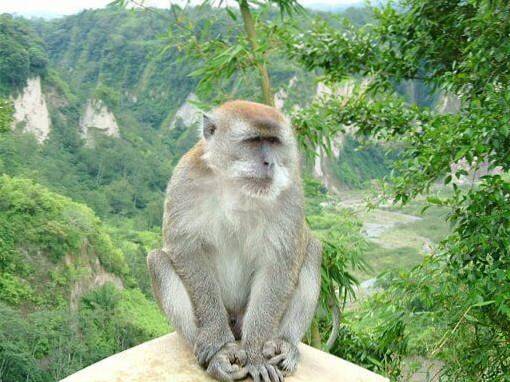
This monkey has been widely used in medical experiments. It is characterized by especially inhabiting the southeast of Indonesia and is considered a species that threatens biodiversity.
This threat has been generated because the crab-eating macaque has been introduced by humans in habitats that do not correspond naturally to it..
They can measure up to 55 centimeters and can weigh up to 9 kilos. Their tail is quite long, which is why they are also known as long-tailed macaques..
They feed mainly on fruits, although they can also eat some invertebrates, seeds and even fungi.
Birds
One of the most important bird species in the Park is the orange-tailed Norway lobster. 27 different bird species live in the savanna areas. In mixed habitat areas, 28 different species of birds live.
Marine fauna
Komodo National Park has one of the richest marine ecosystems in the world. Including 260 species of corals, 70 types of sponges, 1000 species of Ascidians, marine worms, mollusks, echinoderms, crustaceans, cartilaginous fish and fish.
On the other hand, it is home to reptiles and marine mammals (dolphins, whales and dugongs) (Nature conservancy, 2004).
Flora
Komodo National Park is characterized by an arid climate thanks to which savanna habitats predominate. In these spaces there is a hot and dry environment.
In the park there are also some cloud forests; these are less abundant, but they are home to a large amount of the fauna present in the park.
In the same way, it is possible to find mangroves in the bays of the park, which are protected with the intention of preserving the biodiversity of the area..
The 6 most important representatives of the flora of the Komodo Park are described below..
Grasses
Most of the park has a dry climate with small trees. These are basic characteristics of the savanna ecosystem.
In this ecosystem it is common to find grasses, plants that have a high level of adaptation, which is why they are one of the most widespread on the planet..
Bamboo
At the highest elevations in the park you can find a bamboo forest. This species is part of the grasses and is characterized by growing in tropical climates. Bamboo is quite widespread in the Asian continent.
The bamboo forest found in Komodo Park is considered ancient, since it is believed that the formation of this island was generated about a million years ago.
Teak tree
It is a very peculiar tree that stands out because it maintains its quality when used together with some metal.
This, added to the beauty of its wood, has made it one of the trees most used in the manufacture of furniture..
This tree grows in soils with a high level of drainage and abundant calcium. Since it is very well adapted to dry climates, the teak tree is frequently found in Komodo.
Eucalyptus
Eucalyptus forests are found in abundance throughout Asia. Despite the fact that this plant is native to Australia and Southeast Asia, it has been inserted in different areas of the planet.
This tree grows quickly and has more than 300 different species. Its height can be close to 70 meters.
It is characterized by absorbing enough water from the soil, for which in some cases it is planted in specific populations to avoid the development of mosquitoes and diseases generated by them..
Asian palm tree
It is also known as borassus flabellifer. It is a large tree, which can reach 30 meters in height.
The Asian palm has a sap that is used as a laxative and its root is considered partially poisonous..
The fruit of the Asian palm tree is black. Under this peel there is a very soft and fleshy whitish pulp.
Moss
Moss is one of the most widespread plants on the planet, thanks to the fact that it can arise in humid habitats of very varied characteristics.
In Komodo there are different species of mosses. These can measure up to 10 centimeters and are located in the humid areas of the park.
References
- Conservation, D. o. (2000). 25 Year Master Plan for Management, Komodo National Park. Department of Nature Protection & Conservation.
- Komodo, P. N. (June 5, 2015). Putri naga komodo. Obtained from Threats to Biodiversity: komodonationalpark.org.
- , P. N. (July 19, 2013). Putri naga komodo. Obtained from How to Get There: komodonationalpark.org.
- Murphy, J. B., Ciofi, C., Panouse, C. d., & Walsh, T. (2002). Komodo Dragons: Biology and Conservation. Smithsonian Institute.
- Nature conservancy, I. C. (2004). A Natural History Guide to Komodo National Park. Nature conservancy, Indonesia, Coastal and Marine Program.
- Park, K. N. (March 30, 2017). Komodo National Park. Retrieved from Reservation: komodonationalpark.org.
- (2017). UNESCO. Retrieved from Komodo National Park: whc.unesco.org.
- EFE Verde (2014). "Komodo, much more than the land of the dragon." EFE Verde: efeverde.com
- "Poaceae". Wikipedia: wikipedia.org
- "Crab-eating macaque". Wikipedia: wikipedia.org
- International Union for Conservation of Nature and Natural Resources. "Komodomys rintjanus". International Union for Conservation of Nature and Natural Resources: iucnredlist.org



Yet No Comments